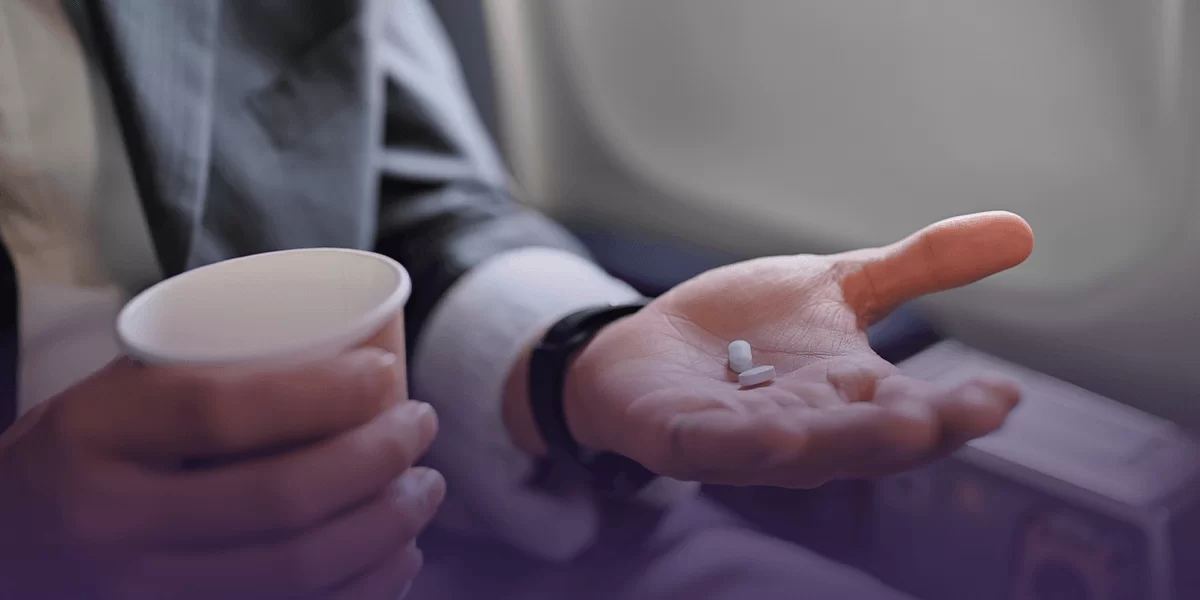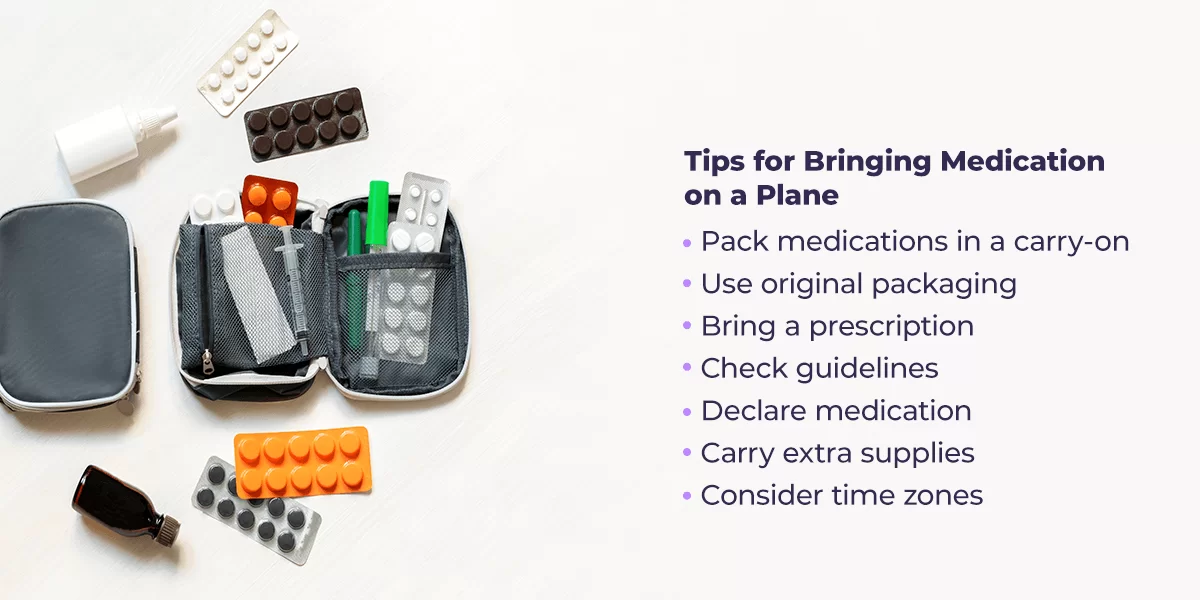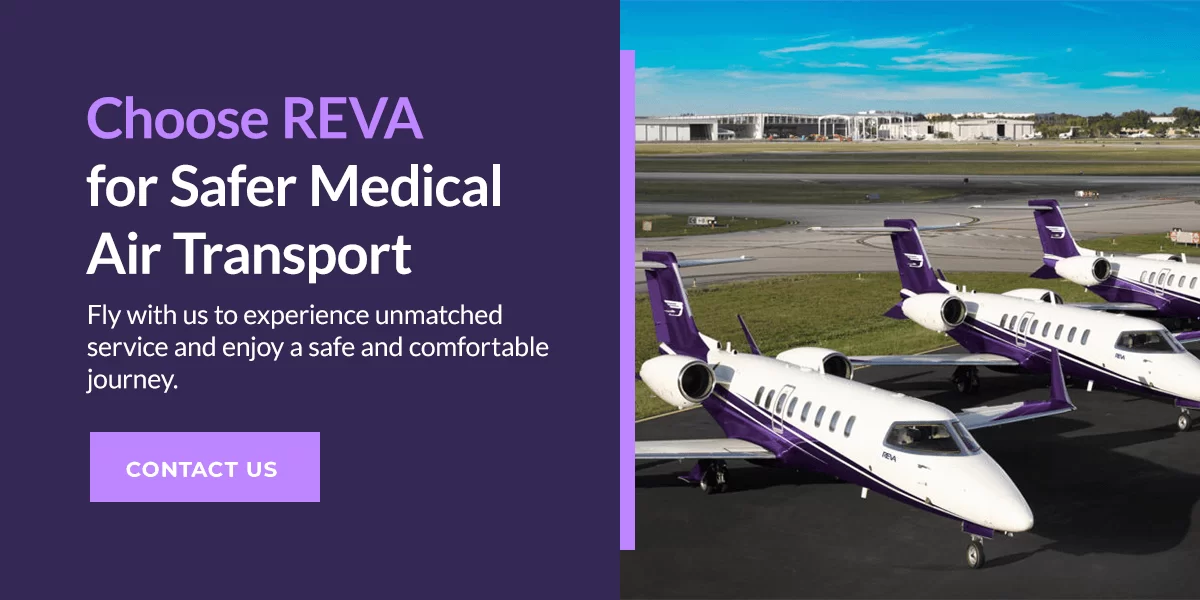Can You Bring Prescribed Drugs on a Commercial Plane?
Flying with all of your essential medicines can become overwhelming if you aren’t sure of the rules or how to pack. Getting your medication together and ensuring it meets airline regulations is essential for flying safely and comfortably. Let’s go over whether you can pack prescribed meds in your carry-on and tips for flying with medication to help you travel safely.
Can You Bring Your Prescriptions on a Plane?
The Transportation Security Administration (TSA) allows passengers to bring prescription medication on the plane. You might want to transport your medication in the original packaging to make security screening easier, but you do not have to declare your prescription pills while traveling.
If you’re traveling with liquid medications, they can exceed the TSA liquid limit of 3.4 ounces as long as the amount is reasonable for your trip. Additionally, you’ll have to let your TSA screening agent know you have medical liquids so they can perform an additional screening on them.
While you are not required to declare non-liquid medication at the screening, declaring may make your screening process smoother. Additionally, bringing your doctor’s prescription for the medication can be helpful if there are any screening questions or complications. Certain medications may be categorized as controlled substances in different states, and travelers should be aware of any restrictions or additional requirements for these medications.
Can You Bring Over-the-Counter Medicine on a Plane?
Yes, you can bring over-the-counter (OTC) medications on a plane. The TSA allows you to travel with unlimited amounts of solid or pill-form medicines as long as they get screened with the rest of your carry-on bags. Standard OTC medications like allergy medications, pain relievers, antacids and more are all allowed onboard the plane. Liquid OTC medication must be declared and screened.
Can You Bring Prescription Medication on International Flights?
If you’re traveling internationally, make sure you can bring your prescription pills on the plane. Medication rules are different for each country — some countries categorize some U.S. OTC medications as controlled substances, so ensure you’re complying with their laws. Many countries have strict rules about certain medications, and getting your information straight beforehand will help prevent issues at customs.
What Medical Items Can You Bring on a Plane?
The following are a few of the medical items the TSA allows you to bring in your carry-on bag:
- Contacts and contact lens solution
- EpiPens
- External medical devices
- Insulin, insulin pumps and glucose monitors
- Liquid medications and vitamins
- Medical devices
- Pill medications
- Syringes
Some medical items, such as mercury medical-clinical thermometers, can go on the plane in your checked baggage after undergoing special screening. Review the TSA’s list of medical items before your flight to ensure you know what you can bring in your carry-on and what needs extra screening. You’ll fly safely and get through screening as efficiently as possible if you’ve reviewed all TSA procedures.
Keep in mind that some items, like oxygen tanks, are not allowed on commercial airplanes, so you’ll need to arrange other transport or use airline-approved oxygen for the flight.
Tips for Bringing Medication on a Plane
After determining if your medicine is allowed on the flight, you need to pack for your trip. Whether you’re flying with prescription or OTC medication, these tips can make the packing process easier:
- Pack medications in a carry-on: Packing your prescription medications in your carry-on ensures you can always access them during your flight. Additionally, if your checked baggage gets lost during travel, you’ll still have your essential medication on you.
- Use original packaging: Try to keep your medicine in its original packaging, and ensure the labels are clear. When in its original packaging, your medication is easily identifiable during security checks.
- Bring a prescription: You do not need a prescription to fly with your medication. However, having a prescription or doctor’s note can help make screening more manageable, especially if you’re carrying controlled substances or large quantities of medication.
- Check guidelines: Read the TSA’s guidelines to ensure you understand medication policies. Review liquid requirements and rules for carrying liquids in proper containers and sizes. Additionally, make sure you comply with the regulations of the state or country you’re flying to to ensure you only bring the allowed medications.
- Declare medication: When you’re going through security with liquid medication or a controlled substance, declare your substances to the TSA. This step can help reduce delays or confusion during screening, allowing you to get to your gate quickly.
- Carry extra supplies: If you use any medical supplies or devices, always carry spares. Extra insulin, syringes or other materials will help you stay safe amid unexpected losses or delays.
- Consider time zones: If you’re traveling with time-sensitive medications, take your destination’s time zone into account. You want to avoid getting off-schedule when you land, so double-check your clocks, timers and alarms.
Using Non-Emergency Medical Transport to Fly With Medical Items
If you need to fly when you have medical items that are not approved for carry-on, or if you simply want to make your trip easier, consider using non-emergency medical transport (NEMT). While the TSA allows most medications and medical items on commercial planes, getting through security and to your destination can be a hassle. NEMTs can provide a reliable, specialized solution for individuals with unique health needs. These services are designed to accommodate passengers with medical conditions, ensuring a safe and comfortable journey, and often include specially equipped vehicles and trained personnel capable of handling various medical equipment.
When flying with medical items, using a NEMT solution allows you to reach your destination quickly and safely. This service particularly benefits individuals who require mobility aids, oxygen tanks or other specialized equipment. The convenience of NEMT services also extends beyond your flight. Providers will often help with pre-flight preparations and medical documentation to make your flight easy.
Choose REVA for Safer Medical Air Transport
If you’re looking for safe, easy medical air transport, make REVA your trusted provider for emergency and non-emergency medical air transport services. REVA employs a team of highly trained medical professionals, state-of-the-art equipment and a stringent safety protocol, all to ensure you get to your destination safely.
With over 30 years of experience, REVA has established itself as a leader in the industry, specializing in medical flights tailored to individual needs. Fly with us to experience unmatched service and enjoy a safe and comfortable journey for anyone with unique health requirements. Contact REVA online for a free medical escort quote today!



